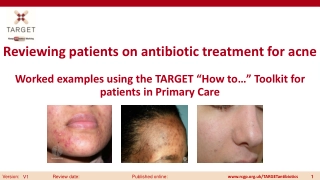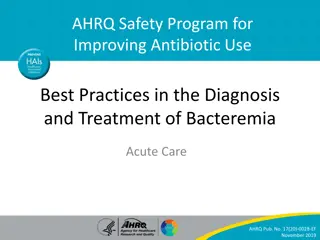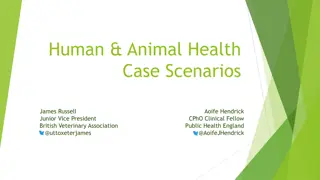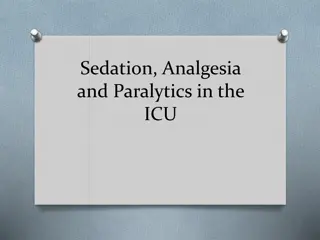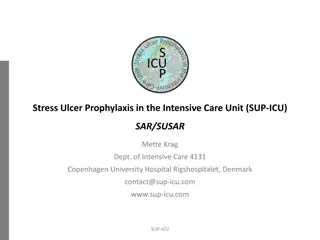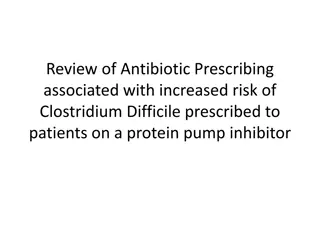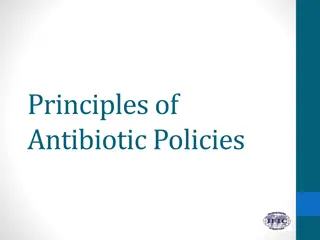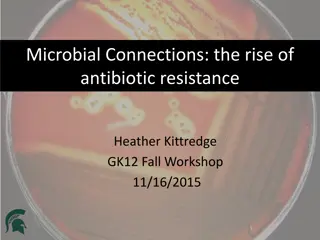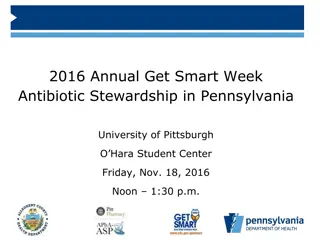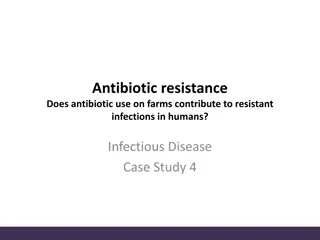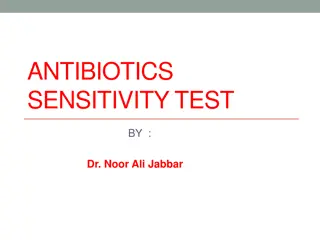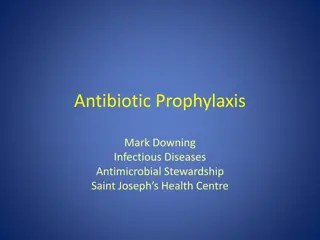Understanding Antibiotic Therapy in the ICU: Strategies and Considerations
Delve into the world of antibiotic therapy in the intensive care unit (ICU) with a focus on identifying the enemy pathogens, selecting the appropriate antibiotics, and formulating effective treatment plans. Explore the nuances of Gram-positive and Gram-negative bacteria, along with other key bacterial species commonly encountered in critical care settings.
Download Presentation

Please find below an Image/Link to download the presentation.
The content on the website is provided AS IS for your information and personal use only. It may not be sold, licensed, or shared on other websites without obtaining consent from the author. Download presentation by click this link. If you encounter any issues during the download, it is possible that the publisher has removed the file from their server.
E N D
Presentation Transcript
Antibiotic therapy in the ICU Dr.Srilekha Ammapalli MD DM 1 Specialist criticalcare, Mediclinic Welcare hospital
Objectives 2 Know the enemy ? Know the weapon ? Formulate the plan based on the possible enemy ?
How strong is our How strong is our enemy? enemy? 3
4 Some are born great!! Some have greatness thrusted upon them Some achieve greatness!
Objectives 5 Know the enemy ? Know the weapon ? Know the plan ?
Gram positive 7 Cocci Bacilli Catalase positive Staphylococci Streptococci Aerobic Anaerobic Coagulase positive CONS Staphylococcus aureus No Novobiocin sensitivity Partial hemolysis (alpha) Complete hemolysis (Beta) hemolysis (gamma) Listeria Bacillus Clostridium Staphylococcus epidermidis Optochin sensitive Corynebacterium BAcitracin sensitive Staphylococcus saprophyticus Streptococcus agalactiae Streptococcus viridans (unencapsulate d) Streptococcus pneumonia (encapsulated) Non Streptococcus pyogenes Enterococcus fecalis, fecium enterococcus Streptococci. bovis
Other gram negative bacilli with special growth requirements Gram Negative Hemophilus species Campylobacter species Legionella pneumophila Bordetella species Brucella species Francisella Helicobacter pylori 8 Bacilli Cocci Anaerobic Aerobic Aerobic Anaerobic Glucose fermentation Bacteroides spp. Prevotella spp. Porphyromonas spp Fusobacterium spp Veillonella spp Neiserria Gonorrhea Neisseria Meningitidis Moraxella catarrhalis Fermenters Non fermenters Oxidase test Negative Positive Pasteurella spp Vibrio spp Aeromonas Plesiomonas E.coli Klebsiella Salmonella spp Shigella spp Yersinis spp Proteus spp Providencia spp Enterobacter spp Serratia spp Citrobacter spp Morganella spp Oxidase test Positive Negative Enterobacteriacae Stenotrophomonas maltophila Acinetobacter speccies Pseudomonas aeruginosa
Gram positive bacteria Gram negative bacteria Atypical bacteria Staphylococci Enerobacteriacae2 Legionella 9 Pneumococci Pseudomonas Chlamydia Other streptococci1 Neisseria Mycoplasma Enterococci H. influenzae Brucella Listeria monocytogenes Campylobacter jejuni3 Rickettsia Bacillus anthracis Helicobacter pylori Acinetobacter Anaerobic bacteria Spirochetes Mycobacteria Clostridia4 Treponema pallidum M.tuberculosis Bacteroides Borrelia Burgdorferi M.leprae Leptospira interrogans M.avium complex 1. 2. 3. 4. S.pyogenes, s.agalactiae, s.viridans E.coli, klebsiella, proteus spp, salmonella, shigella spp V.cholera C.perfringens, C.tetani, C.botulinum, C.difficile
Objectives 11 Know the enemy ? Know the weapon ? Know the tricks of how to attack ?
Classification of antibiotics based on mechanism of action 12 Cell wall Protein synthesis DNA replication Beta lactam antibiotics Rifamycins Sulfadrugs Penicillins Aminoglycosides Quinolones Cephalosporins Macrolides Metronidazole Carbapenems Tetracyclines/ Glycylcyclines Monobactams Chloramphenicol Glycopeptides Clindamycin Daptomycin Linezolid Colistin/polymyxin B Nitrofurantoin
Gram positive Very active 13 Go Gram Negative STOP Atypical CAUTION Anaerobic
Beta lactams 14 3 general mechanisms of bacterial resistance They all share a common structure, the beta lactam ring 1. Decreased penetration to the target site or increased efflux from the target site 2. Alteration of the target site 3. Inactivation by a bacterial enzyme They attach to the penicillin binding proteins on the cell membrane and inhibit the third stage of cell wall synthesis Generally bactericidal
Antibiotics acting on the cell wall 15 Natural penicillins Antistaphylococcal penicillins The Penicillins Aminopenicillins Aminopenicillins + Beta lactamase inhibitors Extended spectrum penicillins Extended spectrum penicillins + Beta lactamase inhibitors
Natural penicillins 16 Penicillin G and Penicillin V are the natural penicillins Natural penicillins Bacterial class Active against Gram positive bacteria Streptococcus pyogenes Viridans group streptococcus Some streptococcus pneumoniae Some enterococci Listeria monocytogenes Some staphylococcus aureus Some CONS CAUTION STO P Gram Negative bacteria Neisseria meningitidis Neisseria gonorrhoeae (except penicillinase producing)) Anaerobic Clostridia species (except clostridium difficile) Actinomyces Israelii Anaerobic streptococci (Peptococcus, Peptostreptococcus) CAUTION STO P Spirochetes Treponema Pallidum Leptospira spp
Nafcillin, oxacillin parenteral cloxacillin and Dicloxacillin oral Addition of an isoxazolyl side chain prevents hydrolysis of beta lactam ring by penicillinases Methicillin, the first agent is not used due to interstitial nephritis Antistaphylococcal penicillins (Penicillinase resistant penicillins) 17 Antistaphylococcal penicillins CAUTION Bacterial class Active against Gram positive bacteria Penicillinase producing staphylococci Some staphylococcus epidermidis Streptococcus spp (less active than natural penicillins) No action against enterococci STO P STO P STO P
Aminopenicillins (Second generation penicillins) Amoxicillin-clavulanate In addition covers Most strains of oxacillin sensitive staphylococcus aureus Betalactamase producing h.influenzae Some Beta lactamase producing entrobacteriacae 18 Ampicillin and Amoxicillin Amino group was added Able to penetrate the porin channel of gram negative bacteria but are not stable to beta lactamases and staphylococcal penicillinases Bacterial class Active against Aminopenicillins Gram positive bacteria Streptococcus pyogenes Viridans group streptococcus Some streptococcus pneumoniae Many enterococci (Ampicillin) Listeria monocytogenes CAUTION CAUTION Gram Negative bacteria Neisseria meningitidis Some Haemophilus influenzae (Non betalactamase producing) Some enterobacteriaceae CAUTION Anaerobic Clostridia spp (Except c.difficile) Actinomyces Israelii STO P Spirochetes Borrelia burgdorferi
Piperacillin-tazobactam Carboxy penicillins Beta lactamase producing staphylococcus aureus Beta Lactamase producing H.influenza Neisseria gonorrhoeae Beta Lactamase producing enterobacteriaceae Anaerobes including bacteroides fragilis Not effective against piperacillin resistant pseudomonas Carbenicillin, Ticarcillin Also penetrate the porin channel of gram negative bacteria Carboxyl group increases resistance to chromosomal beta lactamases (compared to aminopenicillins) 19 Extended spectrum penicillins Bacterial class Active against CAUTION Gram positive bacteria Streptococcus pyogenes Viridans group streptococcus Some streptococcus pneumoniae CAUTION Gram Negative bacteria Neisseria meningitidis Haemophilus influenzae Most enterobacteriaceae Pseudomonas aeruginosa CAUTION Anaerobic Clostridia spp (except c.difficile) Bacteroides spp. STO P
Ureidopenicillins and piperazine penicillin Addition of ureido group produces Azlocillin and Mezlocillin Addition of ureido and piperazine group produces piperacillin Klebsiella, Serratia, Enterobacter, Enterococcus, and increased anaerobic coverage compared to carboxy penicillins Piperacillin has the highest activity against pseudomonas aeruginosa in this class 20 Extended spectrum penicillins Bacterial class Active against CAUTION Gram positive bacteria Streptococcus pyogenes Viridans group streptococcus Some streptococcus pneumoniae CAUTION Gram Negative bacteria Neisseria meningitidis Haemophilus influenzae Most enterobacteriaceae Pseudomonas aeruginosa CAUTION Anaerobic Clostridia spp (except c.difficile) Bacteroides spp. STO P
Piperacillin + Tazobactam Active also against Beta lactamase producing staphylococcus aureus Beta Lactamase producing H.influenza Neisseria gonorrhoeae Beta Lactamase producing enterobacteriaceae Anaerobes including bacteroides fragilis Not effective against piperacillin resistant pseudomonas Not effective against organsims producing ESBL 21 Extended spectrum penicillins Bacterial class Active against GO Gram positive bacteria Streptococcus pyogenes Viridans group streptococcus Some streptococcus pneumoniae Betalactamase producing staphylococcus aureus GO Gram Negative bacteria Neisseria meningitidis (also betalactamase producing) Haemophilus influenzae (also betalactamase producing) Most enterobacteriaceae (including betalactamase producing) Pseudomonas aeruginosa GO STO P Anaerobic Clostridia spp (except c.difficile) Bacteroides spp.
22 First generation Second generation THE CEPHALOSPORINS Third generation Fourth generation Fifth generation
First Generation Cephalosporins Cefazolin and Cephalothin Cefazolin parenteral, cephalothin oral 23 First generation cephalosporins Bacterial class Active against CAUTION Gram positive bacteria Streptococcus pyogenes Some Viridans group streptococcus Some staphylococcus aureus Some streptococcus pneumoniae STO P Gram Negative bacteria Some E.coli Some klebsiella pneumonia Some proteus mirabilis STO P STO P
Second Generation Cephalosporins Two subgroups 1. Active against H.influenza Cefuroxime 2. Cephamycin group active against bacteroides Cefoxitin and cefotetan 3. Less active than first generation against staphylococcus 24 Second generation cephalosporins Bacterial class Active against Gram positive bacteria Cefuroxime Streptococcus pyogenes Some Viridans group streptococcus Some staphylococcus aureus Some streptococcus pneumoniae Cefoxitin and Cefotetan Little or no activity CAUTION CAUTION Gram Negative bacteria Cefuroxime group Hemophilus influenza Moraxella catarrhalis Some enterobacter and some indole positive proteus CAUTION Cephamycin group E.coli, proteus mirabilis, and klebsiella pneumonia STOP Anaerobes Cephamycin group has moderate anaerobic activity Many strains of bacteroides
Third generation Cephalosporins Stable to the common betalactamasas of GNB Cefotaxime and Ceftriaxone poor activity against pseudomonas aeruginosa Ceftazidime and cefoperazone are very active against pseudomonas aeruginosa Ceftazidime and cefoperazone are stable to the plasmid mediated beta lactamases 25 Third generation cephalosporins Bacterial class Active against Gram positive bacteria Streptococcus pyogenes Viridans streptococci Many streptococcus pneumoniae Modest activity against staphylococcus aureus CAUTION GO Gram Negative bacteria Highly active against enterobacterales E.coli Klebsiella pneumoniae Proteus spp.(including indole positive species) Enterobacter Serratia Citrobacter Haemophilus influenzae Neisseria spp. Pseudomonas aeruginosa (ceftazidime and cefoperazone) STOP STOP Spirochetes Borrelia Burgdorferi
Fourth Generation Cephalosporins Cefepime It has a positively charged quaternary ammonium attached , which results in better penetration through the outer membrane of gram-negative bacteria and a lower affinity than the third-generation cephalosporins for inducible chromosomal beta-lactamases of gram-negative bacilli 26 Bacterial class Active against Fourth generation cephalosporins Gram positive bacteria Streptococcus pyogenes Some Viridans group streptococcus Many streptococcus pneumoniae Modest activity against staphylococcus aureus CAUTION GO Gram Negative bacteria E.coli Klebsiella pneumonaie Proteus spp. Hemophilus influenzae Neisseria spp. Enterobacter Indole positive proteus Serratia Citrobacter { Active against the above 4 with inducible chromosomal beta lactamase} Pseudomonas aeruginosa (including ceftazidime resistant ) CAUTION STO P
Fifth Generation Cephalosporins Ceftobiprole and ceftraroline Improved gram positive activity 27 Bacterial class Active against Fifth generation cephalosporins Gram positive bacteria Streptococcus pyogenes Some Viridans group streptococcus Many streptococcus pneumoniae Excellent activity against staphylococcus aureus MRSA, VISA GO Not active against enterococcus GO Gram Negative bacteria E.coli Klebsiella pneumonaie Proteus spp. Hemophilus influenzae Neisseria spp. Some enterobacteriacae CAUTION Anaerobes Some clostridium species STOP
Cefiderocol This siderophore cephalosporin has activity against MDR GNB, including extended-spectrum beta-lactamase- or carbapenemase-producing organisms and multidrug-resistant P. aeruginosa, A. baumannii, Stenotrophomonas maltophilia, and Burkholderia cepacia. In addition to enhanced stability against beta-lactamases, it has a novel mechanism for transport across the outer membrane that can overcome the effect of membrane permeability mutations, as seen in P. aeruginosa Poor gram positive and anaerobic activity 28 Cefiderocol Bacterial class Active against Gram Negative bacteria E.coli Klebsiella pneumoniae Proteus spp. Haemophilus influenzae Neisseria spp. All enterobacteriaceae All pseudomonas aeruginosa Acinetobacter baumannii Stenotrophomonas maltophilia Burkholderia cepacia (ESBL and carbapenemase producing organisms) GO STOP STOP STOP
Combination cephalosporins Ceftazidime avibactam 29 The addition of avibactam to ceftazidime extends the spectrum of activity to include most Enterobacteriaceae (including those that produce AmpC beta-lactamase, ESBL, and some K. pneumoniae and OXA-type carbapenemases) as well as P. aeruginosa species with high MICs to ceftazidime alone. Ceftazidime-avibactam does not have activity against Acinetobacter species or organisms that produce metallo- beta-lactamases and is less active against anaerobes than other beta lactam-beta-lactamase combinations Microbiological efficacy and clinical cure rates with ceftazidime-avibactam were similar to those with meropenem for nosocomial pneumonia , imipenem for complicated urinary tract infection, and, when combined with metronidazole, were overall similar to those with meropenem for complicated intra-abdominal infections Ceftolozane Tazobactam Broad-spectrum in vitro activity against Carbapenem resistant P. aeruginosa and most extended-spectrum beta- lactamase (ESBL)-producing Enterobacteriaceae. It has limited gram-positive activity against streptococci. Enterococcal and staphylococcal species are generally resistant. Clinical cure rates were similar to those with levofloxacin for complicated urinary tract infection caused by levofloxacin-susceptible organisms and, when combined with metronidazole, were similar to those with meropenem for complicated intra-abdominal infections
Carbapenems 30 Generally resistant to cleavage by most plasmid and chromosomal beta-lactamases and have a very broad spectrum of activity Imipinem Inactivated by renal dehydropeptidase I and resulting in low urinary levels of the drug. Combined with cilastatin which is an inhibitor of dehydropeptidase. Can cause CNS toxicity. Not to be used in meningitis Meropenem Spectrum of activity similar to imipinem but stable to renal dehydropeptidase, and lesser risk of seizures Ertapenem Newer carbapenem with narrower spectrum than imipinem or meropenem. Less active than others for pseudomonas aeruginosa, acinetobacter, penicillin resistant pneumococci, enterococci. Long half life and can be used once daily Doripenem Similar spectrum of activity than meropenem but higher invitro activity against pseudomonas aeruginosa than meropenem
31 ESCAPPM or ESCHAPPM is a mnemonic for the organisms with inducible beta-lactamase activity that is chromosomally mediated. E Enterobacter spp S serratia spp. C Citrobacter Freundii H Hafnia spp. A Aeromonas spp. P Proteus spp. (Excluding P.mirabilis) P Providencia spp. M Morganella morganii Treatment with cephalosporins results in inducible beta lactamase activity. Treatment with aminoglycosides or carbapenems is indicated.
Carbapenems 32 Bacterial class Active against Gram positive bacteria Streptococcus pyogenes Viridans group streptococci Streptococcus pneumoniae Moderate activity against staphylococcus aureus Some enterococci Listeria monocytogenes Carbapenems GO Gram Negative bacteria Beta Lactamase producing Haemophilus influenzae Neisseria spp.(including beta lactamase producing gonorrhea) Enterobacteriaceae Pseudomonas aeruginosa Includes organisms producing extended spectrum beta lactamases GO GO Not active against stenotrophomonas maltophilia which has carbapenem hydrolysing chromosomal beta lactamase, burkholderia cepacia Anaerobes Bacteroides fragilis Most other anaerobes STOP
Carbapenem resistant klebsiella, E.coli , and other enterobacterales 33 Bacterial class Active against Gram positive bacteria Streptococcus pyogenes Viridans group streptococci Streptococcus pneumoniae Moderate activity against staphylococcus aureus Some enterococci Listeria monocytogenes Carbapenems GO Gram Negative bacteria Beta Lactamase producing Haemophilus influenzae Neisseria spp.(including beta lactamase producing gonorrhea) Enterobacteriaceae Pseudomonas aeruginosa Includes organisms producing extended spectrum beta lactamases GO GO Not active against stenotrophomonas maltophilia which has carbapenem hydrolysing chromosomal beta lactamase, burkholderia cepacia Anaerobes Bacteroides fragilis Most other anaerobes STOP
Monobactams Not degraded by the class B metallo beta lactamases such as New Delhi metallo beta lactamase 34 Bacterial class Active against Carbapenems Gram Negative bacteria Hemophilus influenzae Neisseria spp. Most Enterobacteriacae Many Pseudomonas aeruginosa STOP GO STOP STOP
Glycopeptides Vancomycin and Teicoplanin 35 Bacterial class Active against Gram Positive bacteria Staphylococcus aureus Staphylococcus epidermidis Streptococcus pyogenes Streptococcus pneumoniae Viridans group streptococci Most enterococci GO Anaerobes Clostridium spp Other gram positive anerobes STOP CAUTION STOP
Daptomycin 36 Bacterial class Active against Gram Positive bacteria Staphylococcus aureus Staphylococcus epidermidis Streptococcus pneumoniae Viridans group streptococci Some enterococci GO Anerobes Some clostridium spp. STOP CAUTION STOP
Polypeptides Colistin, polymyxin B 37 Bacterial class Active against Polypeptides Gram Negative bacteria MDR enterobacteriacae (Carbapenem ressitant klebsiella, pseudomonas, acinetobacter, other CRE) Many stenotrophomonas maltophila Legionella pneumophila Salmonella shigella STOP GO STOP STOP
Rifamycins Rifampin, Rifabutin, Rifapentine, Rifaximin 38 Bacterial class Active against Rifamycins Gram positive bacteria Staphylococci CAUTION Gram Negative bacteria H. influenzae Neisseria meningitidis STOP Mycobacteria Mycobacterium Tuberculosis Mycobacterium avium complex Mycobacterium leprae STOP STOP
Aminoglycosides 39 Bacterial class Active against Aminoglycosides Gram positive bacteria Staphylococci STOP Gram Negative bacteria Enterobacteriaceae Pseudomonas Acinetobacter H.influenzae GO Not active against stenotrophomonas maltophilia, Burkholderia cepacia, or anaerobic bacteria STOP Mycobacteria Mycobacterium Tuberculosis Mycobacterium avium complex Mycobacterium leprae STOP
Macrolides Erythromycin, clarithromycin, azithromycin 40 Bacterial class Active against Some streptococcus viridans Some streptococcus pyogenes Some streptococcus pneumoniae Some staphylococcus aureus Gram positive bacteria Macrolides Neisseria spp Some H.influenzae Some bordetella pertussis Gram Negative bacteria CAUTION Chlamydia spp Mycoplasma spp Legionella pneumophila Some rickettsiae Atypical bacteria CAUTION STOP Mycobacteria Mycobacterium leprae Mycobacterium avium complex GO Spirochetes Treponema pallidum Borrelia burgdorferi
Tetracyclines Tetracycline, Doxycycline, Minocycline Latest Omadacycline Bacteriostatic 41 Bacterial class Active against Staphylococcus aureus Streptococcus pneumonia Streptococcus pyogenes Streptooccus agalacticae Gram positive bacteria Tetracyclines Campylobacter jejuni Haemophilus influenzae Neisseria gonorrhoeae, Neisseria meningitides Vibrio cholera V.vilnificus Gram Negative bacteria CAUTION Atypical bacteria Rickettsia spp Chlamydia spp Mycoplasma spp Coxiella Burnetti CAUTION CAUTION Spirochetes Treponema pallidum Borrelia burgdorferi GO Clostridium spp. Peptostreptococcus spp., Peptococcus spp. Bacteroides melaninogenicus, Bacteroides fragilis Anaerobic bacteria
Tigecycline Bacteriostatic Tigecycline has a reduced potential for resistance, as it is not affected by the two major mechanisms of tetracycline resistance: ribosomal protection proteins and many efflux pumps 42 Tigecycline Bacterial class Active against Streptococcus pyogenes Viridans group streptococci Streptococcus pneumoniae Staphylococci (including MRSA) Enterococci(including VRE) Listeria monocytogenes Gram positive bacteria GO GO Neisseria spp H.influenzae Enterobacteriaceae Acinetobacter Baumannii Serratia MArsecens Stenotophomonas maltophila Gram Negative bacteria GO Mycoplasma spp Atypical bacteria GO Anaerobic bacteria Bacteroides fragilis Many other anaerobes
Chloramphenicol 43 Bacterial class Active against Streptococcus pyogenes Viridans group streptococci Some Streptococcus pneumoniae Gram positive bacteria Chloramphenicol Neisseria spp H.influenzae Salmonella spp Shigella spp Gram Negative bacteria CAUTION CAUTION Mycoplasma spp Atypical bacteria GO Anaerobic bacteria Bacteroides fragilis Some clostridia spp. Other anaerobic gram positive and gram negative bacteria GO
Clindamycin 44 Bacterial class Active against Some Streptococcus pyogenes Some Viridans group streptococci Some Streptococcus pneumoniae Some staphylococcus aureus Gram positive bacteria Clindamycin STOP CAUTION Anaerobic bacteria Some Bacteroides fragilis Some clostridium spp. Most other anaerobes STOP CAUTION STOP
Linezolid 45 Bacterial class Active against Streptococcus pyogenes Viridans group streptococci Streptococcus pneumoniae Enterococci Staphylococci Gram positive bacteria Linezolid STOP STOP GO STOP STOP STOP
Nitrofurantoin 46 Bacterial class Active against Staphylococcus saprophyticus Enterococci Gram positive bacteria Nitrofurantoin STOP Gram negative bacteria Most enterobacteriaceae CAUTION CAUTION STOP STOP
Sulfa drugs Trimethoprim Sulfamethaxazole and Dapsone 47 Bacterial class Active against Some streptococcus pneumoniae Some staphylococci Listeria monocytogenes Gram positive bacteria Nitrofurantoin STOP Gram negative bacteria Some H.influenzae Some enterobacteriacae CAUTION Dapsone Mycobacterium leprae CAUTION STOP STOP
Quinolones Ciprofloxacin, Ofloxacin, moxifloxacin, gemifloxacin, levofloxacin Respiratory fluoroquinolones > Levofloxacin, moxifloxacin, Gemifloxaxcin Antipseudomonal Fluroquinolone Ciprofloxacin or levofloxacin 48 Bacterial class Active against Quinolones Some Staphylococcus aureus Streptococcus pyogenes Viridans group streptococci Streptococcus pneumoniae Gram positive bacteria STOP CAUTION Gram negative bacteria Neisseria spp Haemophilus influenzae Many enterobacteriaceae pseudomonas aeruginosa (Ciprofloxacin and levofloxacin) GO Anaerobic bacteria Some clostridium spp Some bacteroides spp CAUTION Atypical bacteria Chlamydia and Chlamydophila Mycoplasma pneumoniae Legionella spp Ureaplasma GO Mycobacteria Mycobacterium tuberculosis Mycobacterium leprae Mycobacterium avium complex
Metronidazole 49 Bacterial class Active against Anaerobic bacteria Bacteroides fragilis Clostridium spp Most other anaerobes Metronidazole STOP STOP STOP STOP GO STOP


